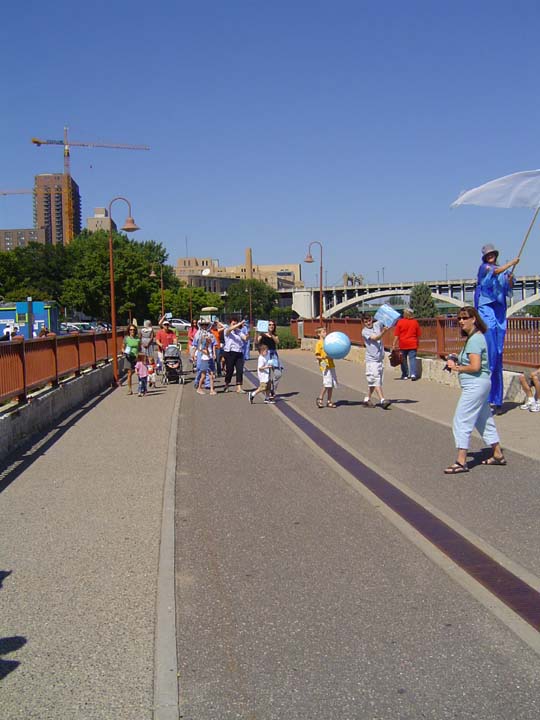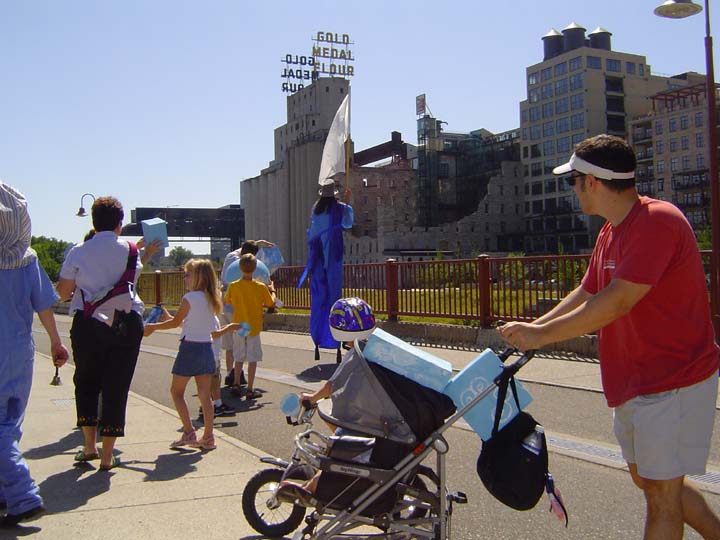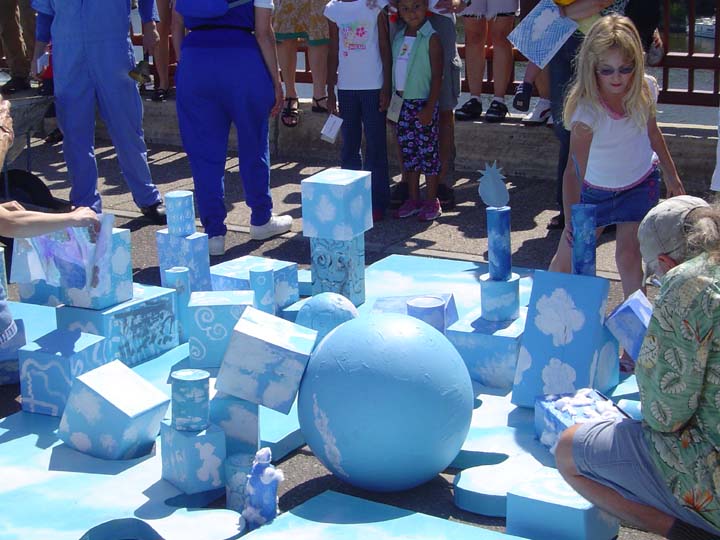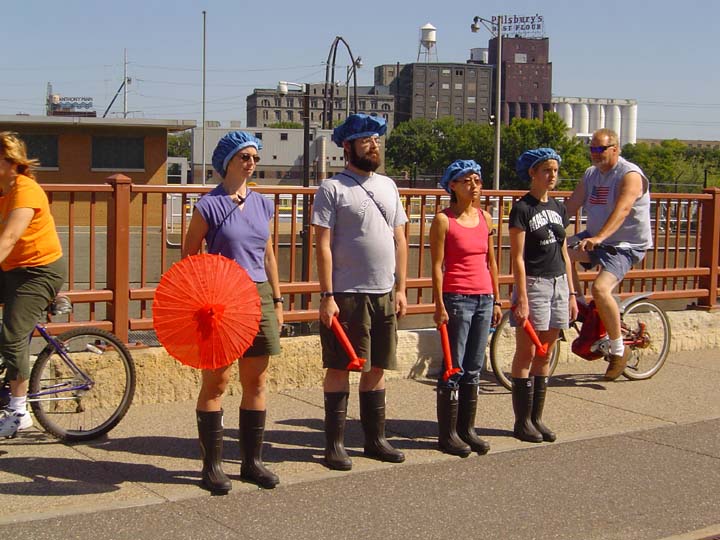Landmark: Between Earth and Sky, Water and Air
Shannon Gibney went to the Landmark event by Local Strategies, on the Stone Arch Bridge at the end of August. It was a high sky-blue day.




“Mom, it’s windy – hold onto your cloud!” exclaims a six-year-old tow-headed girl skipping behind a blue woman on stilts. The mom nods, and clutches a blue and white cardboard square harder.
“We’re almost there!” the blue stilted woman in front exclaims. She is waving a white flag and weaving her way to the right and left sides of the bridge, leading the group. “See the other sky procession?” A three-year-old holding a cylindrical piece of “sky” gasps – “We’re heading right for them!”
He’s right; in about four minutes, the sky processions, starting from each side of the bridge, meet in the middle. The participants place their sections of “sky,” shaped as puzzle pieces, cylinders, rectangles, and everything in between, on the ground in front of them. They don’t just drop them down; everyone takes care to balance each piece beside or on top of the other, in a formation that only the procession members understand.
“I welcome you to the sky!”exclaims Eleanor Savage, a sky procession leader, video artist, and collaborator on the Landmark: 24 Hours at the Stone Arch Bridge project. “See it, feel it, enjoy it, create it!” she says, and everyone starts clapping.
So concludes the sky procession portion of the sometimes absurd and often exhilarating Landmark project, which took place Saturday, August 27 and Sunday, August 28, from sunrise to sunrise, at the historic Stone Arch Bridge in Minneapolis. This free public art event was the brainchild of Local Strategy, a multidisciplinary arts collective.
Throughout the day (and night), participants could take tours of the site with experts in areas such as urban development, power, and the Mississippi river. They were also invited to wander around the bridge, bumping into apron-clad “Knowledge Transfer” volunteers, dispensing knowledge on everything from the bridge’s nineteenth-century history to tips on seeing the art around them.
Over 200 volunteers danced their way across the bridge, played a continuously improvised drone score on a variety of instruments, and manned strategically placed Information Booths, which gave passersby a hint of what was going on.
One such volunteer was Gabrielle Civil, a Knowledge Transferrer who said that about half the people she encountered knew what was going on already and came down to the bridge to participate, and about half of them knew nothing about it, and just happened to come by for their daily walk or jog. “I think people are taking from the experience the idea that Minneapolis is a place where interesting things are happening all the time, and that it’s a place where art and life come together,” she said.
Minneapolis resident Nicole Sela concurred. “When you live here, you don’t learn about any of the tourist attractions like this [the Stone Arch Bridge],” she said. “Not only is this beautiful, but there’s a lot of history here that we don’t know about here in Minnesota.”
Patricia Fitzgerald and her boyfriend Ryan Kronzen said that they appreciated Local Strategy’s approach to the day. “Using performance to highlight certain aspects of the city that may be less paid attention to on a daily basis is a great idea,” said Kronzen.
“I actually hadn’t walked along the Stone Arch Bridge before, surprisingly,” said Fitzgerald. ”I’d been to the Mill City Museum, so I knew the history and everything. We liked the pieces of sky going across [the bridge during the sky procession]. I liked [a Landmark participant’s] outfit of a gardener pushing a wheelbarrow with sky. That’s a great image.”
Tay Damour, a New Orleans resident whose daughter is a Landmark organizer, said that the most meaningful moment of the day for her was the beginning. “I was here at a quarter of six,” she said. “Twenty-five people sat and meditated as the sun rose with huge balloons going up. They went up 600 feet of fish twine, that’s how high. Each of them carried a little bucket of water, suspended. It was just beautiful – the water, moving over the water, and the air. It was just incredible imagery. That whole idea: we’re moving water over the water, and the water’s moving around us, and how intertwined everything is.”
For me, the day made me look at the bridge again for the first time. I saw the falls that had eroded, the mills churning out flour, the Dakota tribes gathering at the river’s edge. And then suddenly, a languid train whistle, humming to my right. When I turned around, I saw a “ghost train,” made of silver shimmering material, gliding by, pedaled by a young woman. The ghost train traveled on the 1918 schedule that the actual train ran on when it was functioning here. In a flash I could see it all – the train, the steam, the rich men and women eating their dinners in the elaborate dining car – and then they vanished, and the blue stilted woman was coming toward me, followed by children carrying cardboard pieces of the sky. I laughed out loud, and grabbed my own piece of sky to carry. Somehow, it all made sense.